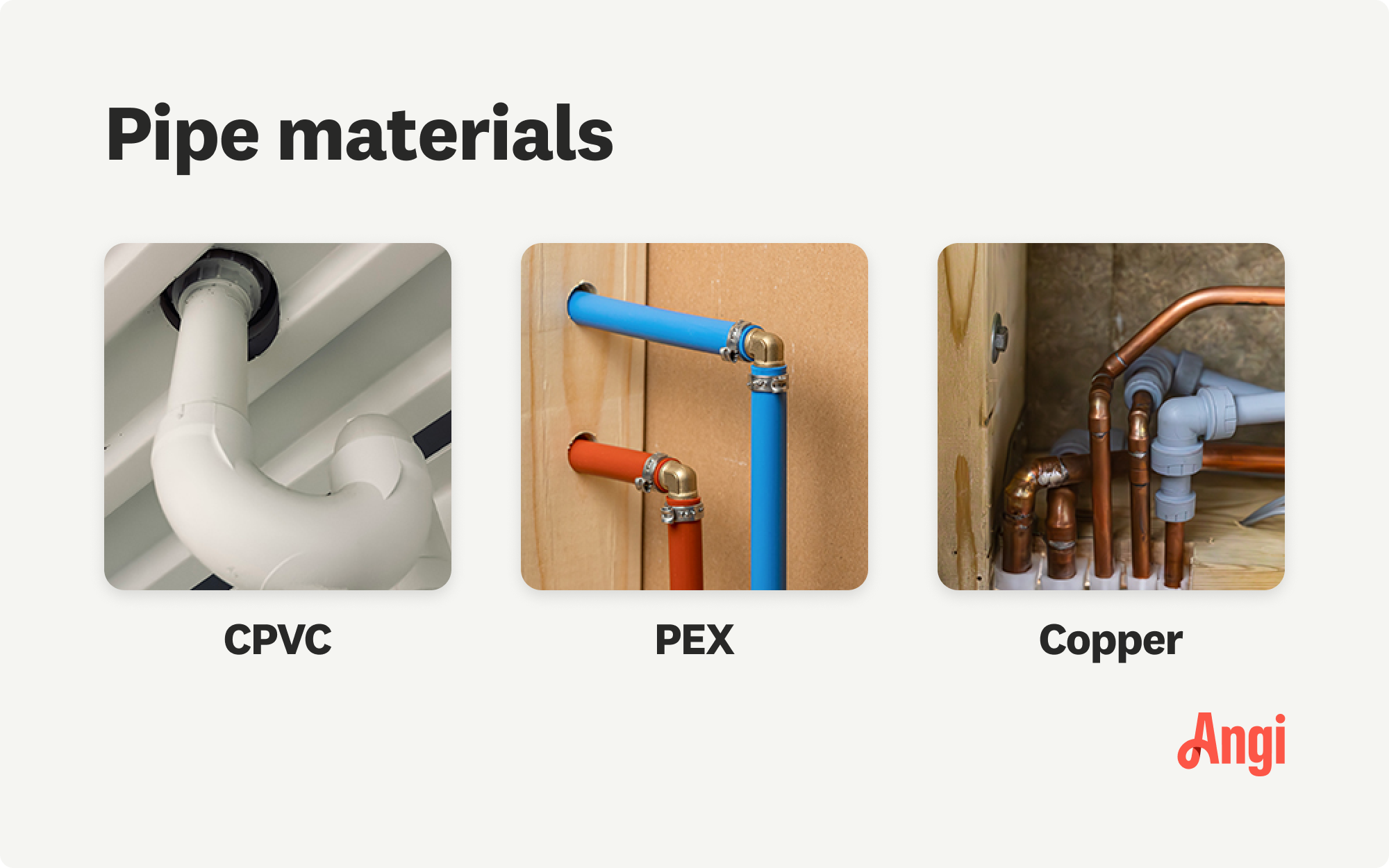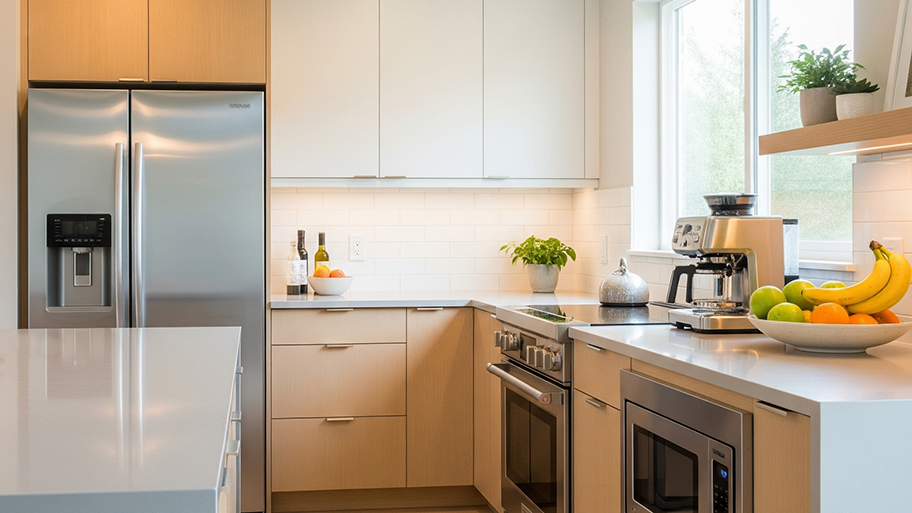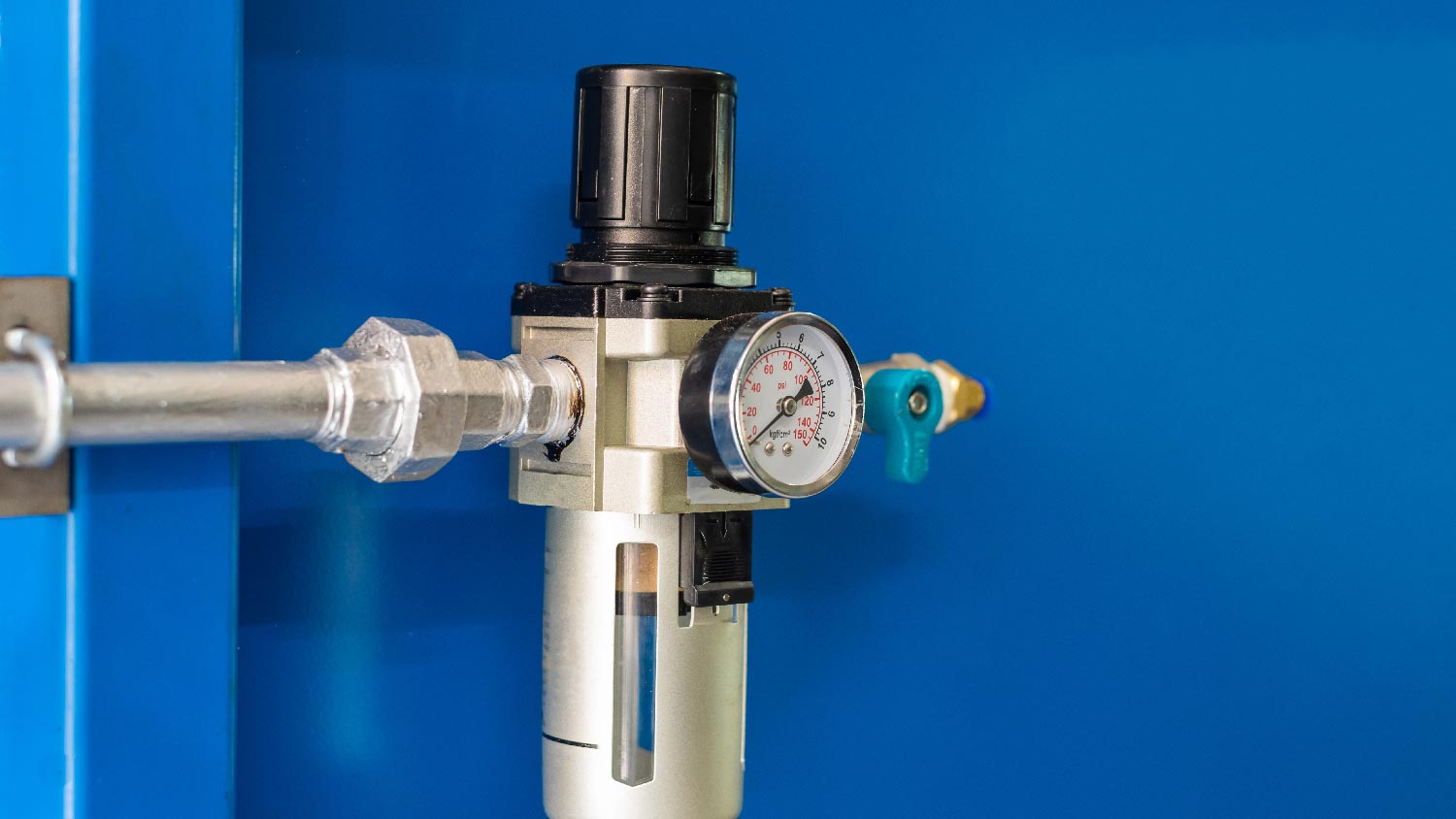
The cost to cap a gas line is relatively low, as plumbers can handle the job in roughly an hour. We break down cost factors and DIY considerations.
Pipe replacement averages $1,253 and ranges from $372 to $2,134. Your plumbing repair pro can assess your home and estimate the overall cost.


Pipe replacement costs will depend on the type of pipe you’re replacing, its length and diameter, inspections, permits, and access to the plumbing.
CPVC pipes are the least expensive to replace, followed by PEX and then copper.
The cost to replace a pipe is between $45 and $200 per hour for labor plus the cost of materials.
If a plumber needs to open up walls, ceilings, or floors, you’ll likely have to bring on another contractor to help repair these areas once the new pipes are installed.
If you need to replace lead or galvanized pipes, you can expect to pay a few thousand dollars depending on how many need replacement.
Pipes are the circulatory system of your house. They deliver drinking water, clean dishes, fill the bathtub, and send wastewater on its way. But when they age or freezing temperatures and serious clogs get in the way, single pipe replacement costs between $149 and $5,800—or $150 and $250 per linear foot. On average, replacing a pipe costs $1,253 for materials and labor.
This price range accounts for everything from the P-trap under your bathroom sink to the sewer line below your yard. Read on to learn more about the ins and outs of pipe replacement costs.
Not all leaks, burst pipes, and signs of corrosion call for replacing large amounts of plumbing. In many cases, a plumber can replace a small section of the pipe affected by the damage. Burst pipe repair costs, for example, only account for replacing the concentrated affected area. However, some jobs are more complicated than others, and materials play a large role in water pipe replacement costs.
Shaddai Plumbing team is great! They are very professional, they keep their word, they complete job without delays. Great quality. We had to replace old water pipes across 2-story home and their service was great. We asked to add additional water switches to be able to switch hot/cold water on and off in separate parts of home - and they did it. Now if it will be leak or other problem - we can switch off kitchen area, or second floor without impacting other parts of our home. Highly recommended!
Generally speaking, there are three main types of piping used in modern installations, each with its own cost ranges, advantages, and disadvantages.

| CPVC | PEX | Copper |
|---|---|---|
| Least expensive | Budget-friendly | Most expensive |
| Prone to leaks | Prone to freezing | Prone to freezing and corrosion |
| Corrosion-resistant | Corrosion- and leak-resistant | Recyclable and UV-resistant |
Chlorinated Polyvinyl Chloride Piping (CPVC): CPVC costs about $0.50 to $3 per linear foot. It's a rigid, time-tested pipe used since the 1960s, but it is prone to leaks due to improper fittings, lower-quality manufacturing processes, or incorrect installation. However, it does not corrode and can be an inexpensive alternative to copper when used correctly. It lasts anywhere from 50 to 75 years.
Polyethylene (PEX) Piping: PEX Pipe runs between $0.40 and $4 per linear foot. PEX is a flexible tubing, made from crosslinked HDPE (high-density polyethylene) polymer and is great for small sections of repair or full replacements. It does not corrode, leak, or burst like other pipes. It's also great for in-floor heating and new construction and can be coupled to any other material type. Keep in mind that PEX piping can still freeze, so you'll need to properly insulate the pipes to prevent breakage. Also, it may not integrate with every pre-existing system, so be sure to inquire with your pro. PEX tubes last anywhere from 80 to 100 years.
Copper Piping: Copper pipes cost $2 to $12 per linear foot for the materials alone, depending on the diameter of the tube, and can have a higher plumbing installation cost when you compare copper pipe to PEX or CPVC. It’s more expensive than plastic but has decades of successful use in homes across the country and is accepted by all building codes. Copper piping is recyclable, UV resistant, and does not leach harmful bacteria. It is also reliable in natural disasters. However, copper pipes can freeze and corrode, so you'll still need to know how to handle a burst pipe. Copper pipes last 50 to 100 years.
You’ll spend more on materials if you need to install a longer pipe—but there may also be some hidden costs. Longer pipes interfere with a larger portion of your floors, ceilings, or walls (think: drywall and floor plank replacement). You’ll have to pay more to repair these elements on top of the pipe installation cost.
Similarly, pipe diameter impacts price. Pipes with a larger diameter require more materials, so they cost more to install. Typically, large-diameter pipes drain waste rather than move water. That said, they can make your plumbing more efficient.
New water pipe installation projects are bid by the fixture, like a bathtub, sink, or toilet. The price will vary depending on how much of the plumbing requires replacement and the cause of the damage. For example, the average cost to repair a leaking pipe starts at $150, but the price depends on where the pipe lives. Expect to pay anywhere from $70 to $1,000 per fixture.
Let's look at a few examples and the related water pipe replacement costs:
Kitchen sink repair costs: $150–$500
Toilet pipe repair costs: $70–$700
Water main line repair costs: $360–$1,700
Bathroom sink repair: $200–$800
A primary cost factor in your total pipe installation costs comes down to labor. Hiring a plumber costs between $45 to $200 per hour, though some plumbers will charge a flat service fee to cover travel and supplies.
Pipe replacement will take anywhere from two to three hours for a simple job and several days for complex repairs. For example, replacing a series of pipes behind drywall will increase the size and timeline of the job. Plumbers may also charge extra for complex jobs involving old pipes, significant clogs, or hard-to-access areas.
Many plumbing projects require a permit—especially if you’re doing a significant job like rerouting plumbing lines under your foundation. A plumber near you can obtain the permit, and they’ll build it into your total plumbing installation cost. On its own, a plumbing permit costs $50 to $500. Make sure you check with your local municipality before you begin.
If the pipes in question contain hazardous materials such as lead, galvanized steel, or polybutylene, you will likely need to remove these old materials before installing new plumbing. When it comes to smaller projects like these, most plumbers will incorporate the cost of removal and pipe disposal into their estimate by adding additional time or including the removal in their flat fee.
The primary cost factor when removing old pipes comes down to related excavation. A plumber may need to remove drywall or part of the ceiling to reach corroded pipes. Repairing a ceiling costs $300 to $1,000, and repairing drywall costs $300 to $800—but we'll go into this more below.
The main water line is the primary pipe that delivers drinking water to your home. In most cases, it runs underground from the water utility line to the foundation.
Pipe replacement costs in this case are much higher than simply swapping out a pipe behind the bathroom sink. Your plumbing pro may have to perform extensive excavation to replace a water line as well as piping materials that can cost up to $10 per linear foot. Overall, you'll pay an average of $1,800 for the cost of main water line replacement, or $50 to $250 per linear foot.
In the event of a plumbing emergency, it is critical to know the location of your water main shut-off valve in case you need to quickly stop water from flowing into your home. If you are unsure, a pro can help you locate the valve and show you how to operate it.
If you're concerned about how to find a leak in your pipes, calling a plumber for an inspection is your best bet for catching it. Most plumbers charge a basic flat service fee to come out to your house to take a look, an average of $150. You can also schedule a full home plumbing inspection for an average of $200, but this involves quick overview inspections to ensure your overall system is in top shape.
Additionally, sewer line inspections are in a category of their own. The cost of a sewer line camera inspection, for example, averages $1,000 and is only necessary if you're concerned about a major clog or crack.
Accessibility greatly affects how much time and energy will be required to replace a pipe. A plumber may need to remove a portion of a wall or ceiling to access the pipe in question, and in some cases, call in an electrician to work around the wiring. Hard-to-reach pipe replacement costs can push up to $2,000 when you need to remove major barriers to finish the work. Pipes out in the open—such as under your sink or in your basement—may cost as little as $150 to replace.
Some specific examples of difficult-to-access areas include main water line replacement, pipe replacement below hardwood floors, or rerouting pipes below a concrete slab foundation.
If you open up your walls, ceiling, and floors to access a pipe, you need to close it back up again. Plumbers may or may not offer assistance with this work. In most cases, you will need to bring in a separate contractor or patch the area yourself. Call on ceiling repair contractors in your area, a team of local interior painters, or—if you broke through a particularly fancy wall—a nearby handyperson to rehang the wallpaper. Here are some related costs for repairing these areas:
Drywall large hole repair: $50–$75 per square foot
Ceiling repair: $45–$90 per square foot
Floor repair: $2–$30 per square foot
Paint an interior room: $2–$6 per square foot
Water damage repair: $3–$7.50 per square foot
Material costs and labor vary by location, so it’s important to speak with a local plumber to get an accurate quote. Speaking with at least three plumbers can help you get the best quote. Plumbing a home will cost more in populated urban areas than in suburban locations, though remote and rural areas may feature an increased price range if homes are far away from the water main. Here are some price estimates for several locations throughout the U.S.
| Location | Average Price |
|---|---|
| Minneapolis | $1,130 |
| Seattle | $2,090 |
| Dallas | $970 |
| Long Island, NY | $960 |
| Chicago | $1,430 |

Rough-in plumbing happens when you build or remodel a home. It’s the process of installing all the pipes in your walls before installing the final fixtures, like your sink or toilet. You’ll spend $4.50 to $5.25 per square foot, but the total cost depends on the number of appliances and piping they need.
| Location | Average Price Range |
|---|---|
| Sink | $350–$500 |
| Dishwasher | $400–$650 |
| Water Heater | $400–$1,800 |
| Furnace | $700–$1,700 |
| Washing Machine | $300–$1,500 |
| Whole bathroom | $1,600–$11,600 |
| Whole home | $8,000–$13,500 |
So, what happens when you have a bigger job than replacing a single pipe? Sometimes, you may need (or want) to replumb a whole home—like if you’re doing a complete remodel, want to swap out aging galvanized or lead pipes, or your piping is over 50 years old.
The cost to repipe a house is between $1,500 and $15,000, and the average homeowner spends $7,500. You can expect to spend $0.40 to $8 per linear foot on the piping, depending on the type of pipe. Copper is on the higher end, and labor is an additional $1 to $4 per linear foot.
Though the overall cost depends on the size of your home, here are some common prices.
| Plumbing Job | Average Cost Range (Materials and Labor) |
|---|---|
| Replacing lead pipes | $1,500–$15,000 |
| Replacing galvanized pipes | $1,500–$15,000 |
| Removing existing piping | $1,000–$5,000 |
| Installing new piping | $2.50–$15 per linear foot |
| Replacing water main | $800–$2,000 |
| Installing a new sewer line | $500–$2,500 |
| Gas line installation | $300–$900 |
This isn’t handyperson work—you want to hire a professional, licensed plumber to do the job. They'll work with you to determine which material will work and the best approach to installation. Plumbers carry liability insurance and professional work is covered by homeowners’ insurance. You are risking thousands of dollars in water damage by going the DIY route, not to mention health hazards down the line.
If you need to replace a pipe in your home, there are a few ways you can save on total pipe replacement costs. These cost-saving tips have a larger impact on a big job but can still be valuable for a single pipe replacement:
Choose affordable pipes: If you can, avoid high-end piping and choose something wallet-friendly. For example, you may be able to replace copper pipes with PEX pipes. This will save you around $2 per linear foot, but PEX isn’t heat-resistant, so it’s not always an option. It will, however, increase your home’s energy efficiency, which can save money in the long run.
Choose the diameter wisely: Speak with a pro to choose the right diameter for your project. Large-diameter pipes cost more but may be necessary for certain jobs and efficient plumbing.
Repair pipes ASAP: If you notice leaks or cracks in your plumbing, repair them before they cause larger (and more expensive) issues. This could save you on plumbing replacement costs down the line.
Clean your drains: Clogs can wear down your pipes, so you’ll have to replace them sooner. Try to clean your drains regularly to avoid damaging clogs.
Get multiple quotes: Get quotes from at least three different plumbers. This can help you get a feel for the market and find the best value and pro for the job.
Look into a home warranty: For some homeowners, a home warranty is a worth-it expense that helps reduce the upfront cost of common repairs.
Home is the most important place on earth, which is why Angi has helped more than 150 million homeowners transform their houses into homes they adore. To help homeowners with their next project, Angi provides readers with the most accurate cost data and upholds strict editorial standards. We’ve surveyed thousands of real Angi customers about their project costs to develop the pricing data you see, so you can make the best decisions for you and your home. We pair this data with research from reputable sources, including the U.S. Bureau of Labor Statistics, academic journals, market studies, and interviews with industry experts—all to ensure our prices reflect real-world projects.
Want to help us improve our cost data? Send us a recent project quote to [email protected]. Quotes and personal information will not be shared publicly.
From average costs to expert advice, get all the answers you need to get your job done.

The cost to cap a gas line is relatively low, as plumbers can handle the job in roughly an hour. We break down cost factors and DIY considerations.

The cost to install a water line for refrigerators typically falls between $75 and $130 depending on the materials, labor, and equipment. Read on to learn more.

Discover the average water tank cost, including installation, maintenance, and tips to save. Get transparent pricing and expert advice for your home project.

Find out the average water pressure regulator replacement cost, key price factors, and tips to save on your project. Get transparent, expert-backed cost info.

Are you concerned about a strange noise from your pipes when the toilet flushes? It could be water hammer, an issue with the fill valve, or a number of other problems. Find out what causes these noises and what you can do here.

We’ll show you how to keep pipes from freezing in the winter and how to thaw yours before they burst.